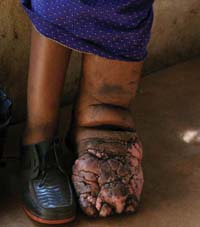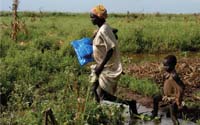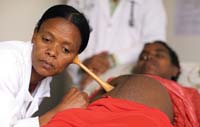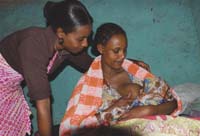Use 'Print preview' to check the number of pages and printer settings.
Print functionality varies between browsers.
Printable page generated Thursday, 20 November 2025, 12:49 AM
Health Education, Advocacy and Community Mobilisation Module: 13. Planning Health Education Programmes: 2
Study Session 13 Planning Health Education Programmes: 2
Introduction
In Study Session 12, you learnt about the purposes and principles of planning your health education activities. You also learnt that the first important step in planning was a needs assessment. In this study session, you will learn the next steps of planning, which are problem identification, setting priorities, and how to develop appropriate objectives and strategies. In addition, you will learn how to develop the components of a work plan. As you discovered in Study Session 12, one of the reasons to conduct a needs assessment is to identify community health problems and their causes. This study session begins by identifying and prioritising the problems which were discovered by needs assessment.
Learning Outcomes for Study Session 13
When you have studied this session, you should be able to:
13.1 Define and use correctly all of the key words printed in bold. (SAQ 13.1)
13.2 Describe the process for identifying and prioritising problems to focus on during your health education activities. (SAQ 13.1)
13.3 Describe the four categories of objectives for health education interventions, and explain how to write good objectives. (SAQs 13.2, 13.3, 13.4 and 13.5)
13.4 List the components of a work plan. (SAQ 13.6)

13.1 Identifying and prioritising health problems
By the end of your needs assessment work, you will have identified a number of health problems in your community. These problems may include a high incidence of malaria, TB, HIV/AIDS, and childhood diarrhoea. You should ensure that you have a list of all the problems you have identified.
You may also have identified some of the possible causes of health problems (Figure 13.1). These could include unhealthy practices such as smoking cigarettes or excessive alcohol consumption. Another possible cause that you might have been able to identify is unhelpful beliefs, such as that malnutrition is caused by bad spirits, or that dirty water causes malaria. Peer influences could also be identified as a cause of some health problems (Figure 13.2). For example, an individual who has malaria may want to visit the health facility to get treatment. However, his friend may want him to go visit a traditional healer.

Once you have identified and listed the main community health problems and their causes, the next step is to prioritise these problems — because it may be difficult for you to address all of these problems at the same time. Prioritisation is the process of arranging the problems in order of the urgency in which they need to be addressed. Highly urgent and important problems are put at the top of your list — and less important and less urgent problems put at the bottom. During needs assessment you may identify as many as 20 different community health problems, but you cannot address all of these at the same time. You now have to prioritise and put them in the order of importance to the health of the community.
Problem prioritisation is not arbitrary, but should use certain established criteria. There are five basic criteria you can use to prioritise problems. Look carefully at Box 13.1. It describes the criteria you can use to prioritise the problems you have identified in your community, in order to decide which ones should be tackled first.
Box 13.1 Criteria to prioritise problems
- Magnitude of the problem
- Look at the prevalence of the problem. Is there a lot of it in your community?
- Are a large number of people affected by the problem?
- Is the problem widespread in the community?
- Severity of the problem
- Does the problem lead to serious illness, death or disability?
- Feasibility of the intervention
- Are you able to solve the problem with the resources you have?
- Can the problem be tackled with the resources you have?
- Government concern
- Do the official people want you to tackle this problem?
- Community concern
- Does the community really want to deal with the problem?
Activity 13.1 Scoring criteria for prioritisation
Knowing the criteria alone cannot help you to set priorities. This activity will demonstrate to you how to score these five criteria, so that you are able to arrange your problems in order of their importance. In the example set out in Table 13.1, each health problem has been scored on a range of one to five. A minimum score would be one. This indicates that there is very little concern for that health problem. The maximum score of five would be given for a problem that was thought to be very severe. The scores for each problem have been added up in the final column, and a rank has been given for each problem. The rank indicates the priority — a problem that is ranked 1 is the most important.
| Problem identified | Score for each criterion | Total score | Rank | |||||
|---|---|---|---|---|---|---|---|---|
| Magnitude | Severity | Feasibility | Government concern | Community concern | ||||
| 1 | Malaria | 5 | 5 | 5 | 5 | 5 | 25 | 1 |
| 2 | HIV/AIDS | 5 | 5 | 5 | 4 | 3 | 22 | 3 |
| 3 | TB | 5 | 5 | 5 | 5 | 4 | 24 | 2 |
| 4 | Diarrhoea | 4 | 4 | 4 | 2 | 3 | 17 | 4 |
| 5 | Typhoid | 3 | 3 | 4 | 2 | 3 | 15 | 6 |
| 6 | Intestinal parasite | 4 | 2 | 5 | 3 | 2 | 16 | 5 |
Now answer these questions on the data in Table 13.1:
- a.According to this scoring system, which is the most important health problem?
- b.Which health problem is considered by the community to be the least important?
- c.Which health problem is considered to be the smallest health problem overall?
Table 13.1 gives a lot of information about this situation:
- a.Malaria has been given the highest rank in this ranking system.
- b.Intestinal parasites have been scored by the community as the least important health concern for them.
- c.Typhoid has only scored 3 in the magnitude column and is ranked 6 out of the six health problems — so is considered overall to be the smallest health problem.
The second option you have available in prioritising health problems is to ask a group of stakeholders, such as community members or other health workers, to prioritise the problems according to their knowledge and experience.
How many problems do you select to address? That really depends on your capacity, and the resources you have to deal with them.
13.2 Setting goals and objectives
Once you have identified the specific problems you intend to address, the next step is to prepare the goals and objectives for your health education activities (Box 13.2). Without goals and objectives your activities may lack direction, and it may be difficult to monitor and evaluate how effective your health education interventions have been.
A goal is a broad statement that can clearly describe what your health education activity is designed to achieve. It provides an overall direction for your activities. Your health goals might be something very general like: ‘My goal is to improve the health of women and children in my locality.’
An objective is more specific than a goal, and it should be achievable. It is the outcome that you want to accomplish through a health education intervention (Figures 13.3 and 13.4). If you do not have objectives, you cannot evaluate the effectiveness and efficiency of your health education activities. An objective has five elements. A good objective must include all of these five elements. Box 13.2 describes them.


Box 13.2 The five elements of an objective
Objective statements must be written in a way that will answer the following questions:
- Things to be achieved: What do you want to achieve?
- Place: Where?
- Target group: Who is the target group?
- Time: When do you want to achieve it?
- Extent of achievements: Can you measure the improvement in health that you have achieved?
Now read Case Study 13.1.
Case Study 13.1 Setting a goal and objective for addressing malaria in your kebele
If your needs assessment has shown that malaria is a problem in your locality, your goal might be very general. You might say something like, ‘My goal is to reduce the amount of malaria in my kebele.’
You may also discover that one of the reasons for the malaria is that the uptake of insecticide-treated bed nets (ITN) is quite low in your kebele, so your objective would be something more specific and detailed. You might decide that your objective should be: ‘To increase the number of households who use bed nets properly in my kebele from 100 to 200 within six months.’
You could look in more detail at this objective:
| ● What? | More people should use bed nets to prevent malaria |
| ● Where? | Throughout my kebele |
| ● Who? | Households, especially those with pregnant women |
| ● When? | Within the next six months |
| ● Extent of achievement | The number should increase by at least 100 households. |
It is important to note that the objective should have a deadline, and it should be achievable. Now try this out with the two examples below.
Bilise is a Health Extension Practitioner. She is working in a village called Sato. She always plans her health education activities clearly. One of the objectives in her plan is: ‘To increase the number of pregnant women who attend for antenatal care in Sato village from 15 now to 35 by the end of three months.’ Has she included all the elements of an objective in her statement? Identify each element that she has used. The bullet points in Case Study 13.1 will help you to organise your answer.
Yes, Bilise’s objective is correctly written. It addresses all the elements that should be included when writing an objective. Each element could have been expressed like this:
● What? Increased uptake of antenatal care ● Where? In Sato village ● Who? Pregnant women ● When? Within three months ● Extent of achievement Increase by another 20 pregnant women.
Suppose Ayisha is a Health Extension Practitioner working at her health post in a village called Deneba. She wants to plan her health education activities on the subject of female genital mutilation (FGM) for village mothers. She intends to educate 100 mothers within the next four months. Based on this information, how do you think Ayisha should write her objective?
Ayisha’s objective could be written as: ‘To provide health education on FGM for 100 mothers who live in Deneba within the next four months.’
13.2.1 Categories of objectives
In health education and promotion activities, there are four types of objectives. Health objectives tell you how big the health problem is, and how much it should be improved. As you learnt in Study Session 12, the first step in a needs assessment is to identify a health problem. Here in the health objectives stage, you should decide by how much you want to reduce that problem.
A typical health objective might be:
- Infant mortality will be reduced in our region to 30 deaths per 1,000 live births by the year 2012.
The next step is to look at the health-related behavioural objectives. The term ‘behavioural objective’ refers to the actions that you encourage people to perform, or not perform (Figure 13.5). For example, health-related behaviour may include using condoms to reduce the risk of diseases caused by unprotected sex, or using an insecticide-treated bed net, or taking anti-malaria drugs properly, and so on. Since the primary objective of health education is to change people’s behaviour; behavioural objectives are very important. You should determine by how much you want to increase healthy behaviours or, conversely, by how much you want to reduce unhealthy behaviours in the community.

Examples of behavioural objectives might include the following:
- To increase the percentage of households who use bed nets from 35% to 70% within six months.
- To increase the number of people who use condoms from 15% to 45% within one year.
Using bed nets or using condoms are behaviours that we want to encourage through health education. Therefore, you should have behavioural objectives for all behaviours that you want to change through health education.
Learning objectives refer to educational or learning tools that are needed to achieve desired behavioural changes. Learning objectives describe the knowledge, attitude, beliefs or skill development that leads to the desired behaviour change. If learning objectives are achieved, then behavioural objectives will be achieved. An example of a learning objective could include:
- ‘At the end of the learning session, 60% of the people who attend will have learnt how to use bed nets correctly.’
Sometimes learning objectives can be developed for health education activities which will be undertaken for a longer period. For example, you might have a learning objective such as: ‘By the end of 2013, 90% of the households in my kebele will be able to identify three means of HIV/AIDs prevention.’
The fourth type of objective is a resources objective. During a needs assessment, you may also identify a lack of resources or services without which behaviour change could not take place. For example, without a mosquito net you cannot expect households to use bed nets properly (Figure 13.6). In general, if there is a lack of resources or services which are important for behaviour change, you should make these services available, and you should have objectives for doing so. Such an objective is called a resource objective. For example ‘by the end of this year all mothers of children under two in this village should have access to oral rehydration salts’.

Now try to identify the four different types of objectives. What kind of objective are each of the following?
- At the end of the learning session, 90% of the people who attended will be able to identify at least two risk factors for catching malaria.
- To increase the number of women who attend antenatal care visits from 21% to 45% within six months in Koticha kebele?
- At the end of this year six out of ten households should own mosquito nets.
- To reduce the number of cases of malaria in my village from 15 to 5 cases within six months.
Answer 1 is a learning objective. 2 is a behavioural objective. 3 is a resource objective. 4 is a health objective.
Now try this out for yourself. Write an example of one behavioural objective and one learning objective for your health education activities on HIV/AIDS.
A behavioural objective might be something like: ‘To increase the number of couples who use condoms in my kebele from 20% to 40% over the next two years.’ A learning objective could be: ‘70% of the people who attend the health education session in my kebele will be able to identify three ways of HIV/AIDS transmission.’
13.3 Selecting educational methods
To achieve each of your stated objectives, you need to choose the best educational method, because not all health education methods are appropriate to achieve each of your objectives — some methods are better than others. For example, if one of your learning objectives is to increase knowledge about a particular health subject, you should choose a method which is appropriate for this objective (Figure 13.7). If one of your objectives is to influence attitudes, you need a different way of getting your message across.

Table 13.2 shows health education methods that are appropriate for each learning objective.
| Learning objective | Health education method |
|---|---|
| Raising awareness and passing on knowledge | Lecture with discussion, talks at public meetings or social gatherings, and the distribution of materials such as posters and leaflets |
| Changing attitudes | Individual approaches such as counselling or discussion, using visual and audio-visual materials |
| Skill development | Training and demonstrations involving practice |
When you are choosing the educational method that you will use, you should also consider:
- The number of people involved.
- Learner preferences.
- The appropriateness of the method to the local culture.
- Availability of your resources.
- A method that best fits the characteristics (age, sex, religion, etc.) of the target group.
13.4 Developing your plan of work
A plan of work is simply putting together all the components you have worked out to deliver your health education messages, such as your objectives and the activities you will use. Your plan should specify the roles of the different people involved, the time in which the particular activities have to be carried out, and the different methods you plan to use. Look carefully at Box 13.3 which describes the components of a work plan.
Box 13.3 What is in a work plan?
Your plan of work should include the following components:
- Clear objectives
- Your strategies
- A list of activities that you will do
- Who will help you
- Resources to be used
- Timing
- Indicators.
As you can see from Box 13.3, an indicator is one of the components of a work plan. An indicator is used to measure changes related to each of your health education interventions. A variable is something that changes over time. For example, knowledge, attitudes, beliefs, skills and health behaviours are all variables, because they can change over time, and you hope that all these things will improve as a result of your work in the community.
For instance, a person’s attitude is not static — it can change. So the variables can indicate, or show, the extent of your achievements. For example, if you educate households about the proper use of bed nets to prevent malaria, your indicator could be the number of households who have used a bed net properly after they have received your health education messages. The variable in this example is people’s behaviour.
To understand how a work plan is developed, look at Table 13.3. This table helps you to visualise how the components of your work plan could be put together, and the relationship between each component. (Note that IEC materials involve Information, Education and Communication).
| Objectives | Strategies/methods | Activities | Responsible people | Resources | Timing | Indicators |
|---|---|---|---|---|---|---|
| To increase the number of households who use bed nets properly from 20% to 60% over the next year. | Home visits.Training each household on the proper use of bed nets Demonstration of bed net use, practising with mothers and families. | Conducting home visits. Identifying barriers to using bed nets, giving advice to families, and helping them to hang bed nets properly. Preparing training materials, selecting participants, giving training. | Community health practitioners, community malaria workers. | IEC materials. Posters, leaflets, papers, pen, pencils, bed nets. Materials to demonstrate use of bed nets such as rope. | August 2012 to September 2013 (International Calendar). | Number of households who received training. Number of households who use bed nets properly after training. |
Creating a work plan takes time and effort. So we are not asking you to do one here and now. But it is useful to familiarise yourself with its shape. So look at Table 13.3 carefully now, and think of a health problem you are aware of in your area. Try just mapping out a work plan in a very preliminary way. Think how you would turn the problem into an objective. Imagine the sorts of activity you would want to undertake. Who do you think would be responsible people to involve? What sorts of resources would you need? What would a reasonable time frame be? What sorts of indicators of change do you think would be helpful?
As we have noted, a work plan is not something which you can just put together in half an hour, but beginning to think about the issues you would need to deal with to construct one is a useful exercise. If you want, you could try it with a number of health problems, and begin to get a feel for what exactly you are going to need to do.
Summary of Study Session 13
In Study Session 13, you have learned that:
- You will need to identify and use the process of problem identification and prioritisation in your work. Since it is not feasible to address all the health problems that have come out of your needs assessment, you should prioritise and select those problems which need urgent intervention.
- You can prioritise your problems according to their magnitude, the severity of the problems, the extent of community and government concern, and the feasibility of addressing problems. You can also discuss with stakeholders, like community members and key informants, what they consider to be their priorities.
- Once you have prioritised and selected the most important problems, the next step is to develop the goal and objectives which you are going to aim to achieve. An objective should include statements of what you want to achieve, where, who is the target group, when do you want to achieve your goal, and how will you measure the outcomes of your interventions.
- There are four categories of objectives. These are health objectives, behavioural objectives, learning objectives and resource objectives. Whenever you prepare your objectives, make sure they are achievable within a certain period of time.
- In order to achieve your stated objectives, you should choose health education methods that are appropriate. You should take account of your learning objectives, the preference of learners, and the culture of the community, when you select your health education methods.
- You will need to develop a work plan to help you plan all your activities in a logical way. The work plan should include your objectives and methods, as well as a time frame.
Self-Assessment Questions (SAQs) for Study Session 13
Now that you have completed this study session, you can assess how well you have achieved its Learning Outcomes by answering these questions. Write your answers in your Study Diary and discuss them with your Tutor at the next Study Support Meeting. You can check your answers with the Notes on the Self-Assessment Questions at the end of this Module.
SAQ 13.1 (tests Learning Outcomes 13.1 and 13.2)
- a.What does problem prioritising mean?
- b.During a needs assessment, you may identify many problems. However, it may not be feasible for you to address all these problems at the same time. What criteria do you use to select a priority problem?
Answer
Prioritisation is the process of placing problems in the order of urgency: highly urgent and important problems are put at the top, and less important and less urgent problems are put at the bottom.
There are five criteria to prioritise health problems for health education interventions. They are magnitude of the problem, severity of the problem, feasibility to solve the problem, community concern and government concern.
SAQ 13.2 (tests Learning Outcome 13.3)
List the five elements of an objective.
Answer
These are the five elements of an objective:
- What to achieve
- When to achieve
- Where to achieve
- Extent of achievement
- Who is the target group?
SAQ 13.3 (tests Learning Outcome 13.3)
What type of objective are each of the following?
- a.To reduce infant mortality by 10% by the end of 2015 in community ‘Y’.
- b.To increase the number of couples who use condoms from 30% to 50% by the end of 2014.
- c.To increase the number of people who seek treatment for malaria within 24 hours by 20% by the end of 2014.
- d.90% of households should be able to identify three types of HIV transmission by the end of 2012.
- e.By the end of this year, 200 condoms will have been distributed for youths in this kebele.
Answer
- a.is a health objective.
- b.is a behavioural objective.
- c.is a behavioural objective.
- d.is a learning objective.
- e.is a resource objective.
SAQ 13.4 (tests Learning Outcome 13.3)
Are these learning objectives correctly written? In each case, explain why the objective is correct or incorrect.
A At the end of the learning session, participants should understand what malaria is.
B At the end of the learning session, participants will be able to identify three methods of malaria prevention.
C At the end of the learning session, 80% of the participants will be able to identify prevention methods against malaria.
D At the end of the learning session, 80% of the participants will be able to identify three methods of malaria prevention.
Answer
A is incorrect because it does not show all the elements of the objective. For example, there is no extent of achievement. The word ‘understand’ is not used to write objectives, as it is difficult to pin down.
B is incorrect because it lacks the extent of achievement.
C is incorrect because the number of prevention methods the participants are supposed to identify is not specified.
D is correct because it includes all the elements of an objective.
SAQ 13.5 (tests Learning Outcome 13.3)
Write an example of one behavioural objective and one learning objective for health education activities on the subject of HIV/AIDS.
Answer
You can write a lot of behavioural objectives related to health education on HIV/AIDS. For example, ‘to increase the number of people who use condoms from 20% to 40%’, ‘to increase the number of people tested for HIV/AIDS by 70 within six months’, and so on.
For a learning objective, you may write that: ‘70% of the people who received health education will be able to identify three means of HIV/AIDS transmission’ or ‘90% of those who received health education should develop the belief that condom use can prevent HIV transmission’, and so on.
SAQ 13.6 (tests Learning Outcome 13.4)
What components should you include in your work plan for a health education programme?
Answer
These are the elements you should include in your work plan:
- Objectives
- Strategies
- Activities
- Responsible people
- Resources
- Time frame
- Indicators.